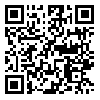BibTeX | RIS | EndNote | Medlars | ProCite | Reference Manager | RefWorks
Send citation to:
URL: http://jdisabilstud.org/article-1-2115-en.html
2- Department of Textile and Clothing Design, Yazd Branch, Islamic Azad University
3- Faculty of Art and Architecture, Islamic Azad University, Tehran Central Branch
Background & Objectives: Blindness always means the inability to perceive the surrounding images and visualize them, which in turn leads to poor sensory perception and social communication. The blind perceives and visualizes the world around them by relying on other senses (hearing, touch, smell, and taste). Thus, the painting of the blind represents an embodiment of the world around them. A review of the literature shows that in the research done so far, the brain ability of the blind in visual visualization, the activity of the visual cortex and its relationship with mental imagery have mainly been studied from a physiological and psychological perspective. In terms of emphasizing the ability of mental visualization in blind people, there are commonalities with this research, with the difference that in the forthcoming research, the focus is on the visual results of this capability. However, the blind and how it is possible to analyze and understand the world of the blind have not been researched in this field. The purpose of the current research was to evaluate and analyze the visual quality of the mental images drawn by the blind.
Methods: This research was conducted with a combined quantitative-qualitative research method, so that the results obtained from painting education to 10 blind people aged 12 to 18 years have been studied. Paintings had three themes: painting based on a tangible model, imaginary painting, and free painting. It should be noted that the tools, conditions and training hours were the same for all members of this group. A total of 100 paintings have been selected as a case study (10 works from each blind person) and were analyzed descriptively based on visual characteristics: color, texture, line, and surface. From the analysis of quantitative results obtained on case samples, the main visual features in the paintings of the blind were inferred and identified.
Results: The research findings showed that, images and forms used in blind painting, regardless of the representation of objects, can also express their thoughts, feelings, and emotions. It is inferred that the use of pure colors, texture, embossing, using dots instead of lines, and 2D drawing were the 4 main visual components in the paintings of the blind. Analyzing the quantitative data of this research and achieving the dominant visual features in the paintings of the blind, as well as its compliance with the views and theories expressed in the theoretical framework, 7 main features were found as features of paintings in the blind: abstractionism, co-institutional (meaning construction of complex concepts from simple elements), hybrid perspective, unconventional and disproportionate composition, use of pure colors, transformation and distortion of familiar traits and symbolism.
Conclusion: According to the research findings, it is necessary to pay attention to the features of blind people's paintings to discover the world inside these people. Painting has an effective role in increasing self-confidence and strengthening the mental imagery of the blind. As a result, it can be used as a useful educational method for the blind.
| Rights and permissions | |
 |
This work is licensed under a Creative Commons Attribution-NonCommercial 4.0 International License. |



